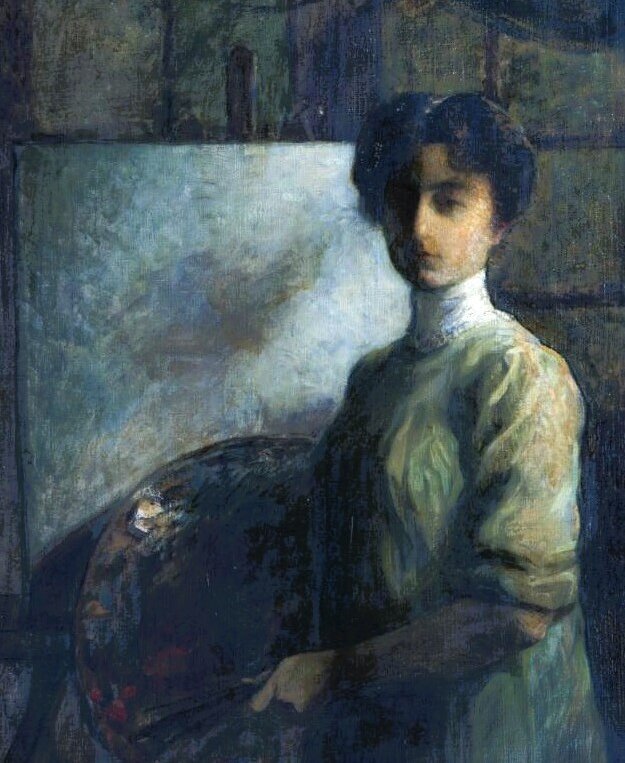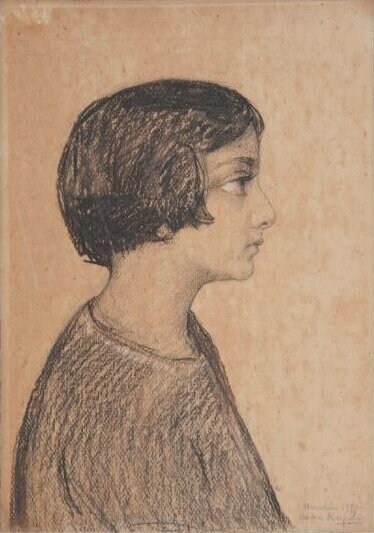Andrée Karpelès
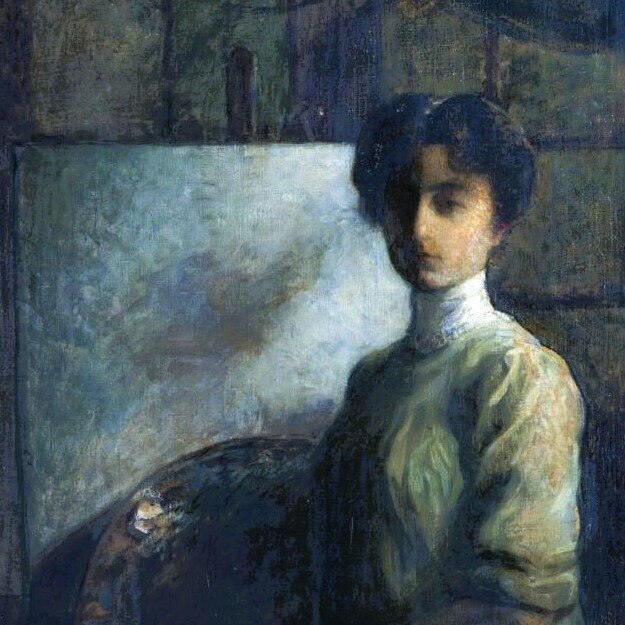
Andrée Karpelès [or Andrée Karpelès-Högman] (18 May 1885, Paris — 5 Sept. 1956, Cannes [buried in Grasse] was a painter, illustrator and writer who made Indian and Cambodian cultures and arts more accessible to the Western discerning public through her work.
A daughter of Jules Karpelès, a successful importer of indigo from India to Europe, and Sophie Philippson, she spent parts of her childhood in Calcutta (Kolkata, West Bengal) along with her sisters, Suzanne (1890−1968) — who was to become the first female member of EFEO and co-founded the Buddhist Institute in Phnom Penh -, and Solange (1888−1900), who died at age 12.
1) “Self-portrait”, undated 2) Sketch for a portrait of Nandini, Rabindranath Tagore’s daughter, undated, two works by Andrée Karpelès donated to the Visva-Bharati collection, Santiniketan, by Flora, her adopted daughter. [source: Udaya Narayana Singh, op. cit.]
As a precocious and noted artist — she had studied under famed French artists René Ménard et Lucien Simon -, her work was featured in various exhibitions starting from 1906, notably with her oil on canvas composition, Sur la Terrasse. Indes, purchased by the Ministry of Culture in 1908 and now living at Paris Musée du Quai Branly-Jacques Chirac. After a long travel across India in 1910, she held her first solo exhibition at Paris Galerie des Artistes Modernes [Modern Artists Gallery], “Indes et Cachemire. Tableaux & Études par Andrée Karpelès.” In 1913, she finally met in Kolkata the Indian artist she had admired since childhood and whom she came to call “my guru”, Abanindranath Tagore অবনীন্দ্রনাথ ঠাকুর; (7 August 1871 – 5 December 1951), also known as ‘Aban Thakur’, a leading figure of the Indian Society of Oriental Art and of the Bengal School of Art, an active exponent of the independentist Swadeshi (self-sufficiency) movement in line with Mahatma Gandhi’s ideals, an acclaimed writer in Bengali language with an emphasis on children’s literature, and a cousin of famed poet Rabindranath Tagore, the 1913 Nobel Prize in Literature.
Four decades later, Andrée recalled her first encounter with Abananibdranath Tagore:
Long ago, in Paris, a little girl was looking at the English magazine, The Studio; she came across a reproduction of one of Abanindranath’s
pictures: an illustration for Kalidasa’s Cloud Messenger; the longing expression of the lonely figure; the dark cloud over the melancholy landscape, the harmony prevailing throughout the whole picture, impressed her in a way she could hardly explain, understand or express. The desire. to meet one day the creator of that picture filled her heart with an unforgettable intensity. Years passed by, unexpected
coincidences brought the young girl (now a painter) to Jorosauko. A‑ba-nin-dra-nath Ta-gore (the syllables had haunted the girl, like the
lovely verse of some mysterious, faraway poem). He was there in front of her; he revealed India’s soul to her ; India’s art ; Bengal’s heart. She
soon called him her “‘ Guru.” Rabindranath Tagore has described Jorosauko in his Boyhood Days but who will ever write the Saga of the whole Tagore family in that mansion filled with art, music, poems, drama, religious and social reforrns ? The young French painter enters, as into a temple, into that enchanted Castle. A curly pet lamb greets you in the courtyard; an imposing “darwan” leads you up the stairs… corridors…sunny terraces…shady zenana…graceful, mysterious silhouettes…at last: the verandah! An impressive Trimurti, three brothers, are there : Samarendranath, with his long lotus-petal eyes, is meditating on philosophy ; Gogonendranath, with his gay smile and his profile of
a Roman Emperor, is busy with some magic kaleidoscope which he has just invented; Abanindranath! High forehead, deep, warm, thoughtful eyes ; extraordinary hands, with refined turned-up fingertips. An oasis in the midst of one of Calcutta’s busiest quarters, a symbol of the best that India can offer; the heart of Bengal seems to throb on the peaceful verandah. […] Through the wide-open window entered suddenly a huge and beautiful parrot; his feathers were all white, except a little crown of yellow ones; he flew straight towards Abanindra and settled down near him. “You know that parrot? ” “No, he has been sent to me from heaven as a reward for what I have said : Originality, tradition, nature. ” And Abanindranath smiled — such a gay, youthful smile which illuminated his unforgettable expressive features ! [Andrée Karpelѐs-Hogman, ‘Abanindranath Tagore’, The Aryan Path, vol. XXIII‑3, 1952, p 119 – 20, 123]
That same year, Andrée Karpelès’ work was showcased at the Carnegie Museum of Art, Pittsburgh, USA (17th Annual Exhibition Apr. 24 – June 30, 1913). Since then her career became closely entwined with the Bengali artists, starting with 1914 when she teamed with Nandalal Bose (3 Dec.1882 – 16 April 1966) — a pioneer in Indian Contextual Modernism and upcoming principal of Kala Bhavan (arts departments) at Visva Bharati University, Shantiniketan, Rabindranath Tagore’s brainchild — in order to organize the first major international exhibition of the Bengal School, in Paris. In 1921 – 1922, she was invited to stay at Shantiniketan and to teach woodblock technique at Visva Bharati. Her closeness to the Tagore family was so profound that, according to Indian author Nirmalkumari Mahalanobis, the Nobelized poet composed as a farewell gift to Andrée upon her leaving back to France the famous song Bharā thāk smŗti sudhāy bidāyer pātrakhāni [“Let the parting bowl be filled with sweet memories”].
It was in Shantiniketan that she met art publisher Carl Adalrik Högman (2 Nov. 1874, Gävle, Sweden — 1958, Grasse, France). As wife and husband since 3 Oct. 1923, the couple launched Chitra, a publishing house specialized in Indian and Asian texts lovingly translated and illustrated, settling in a remote farmhouse on the Clavary hills near Grasse in Provence, which became a “cultural hub” for Indian culture lovers in the 1930s. In 1930, while her sister Suzanne Karpelès headed the Phnom Penh Buddhist Institute and supervised the public opening of the Bibliothèque de Phnom Penh (future National Library of Cambodia ) on 24 De. 1924, Andrée helped in setting up the first exhibition of Rabindranath Tagore’s paintings at Galerie Pigalle, in Paris. Suzanne, the first female full member of EFEO, was not Andree’s only connection to the Ecole, as she had worked closely with Victor Goloubew, the founder of the collection “Les classiques de l’Orient” at Bossard publishing house before joining the EFEO team at Angkor.
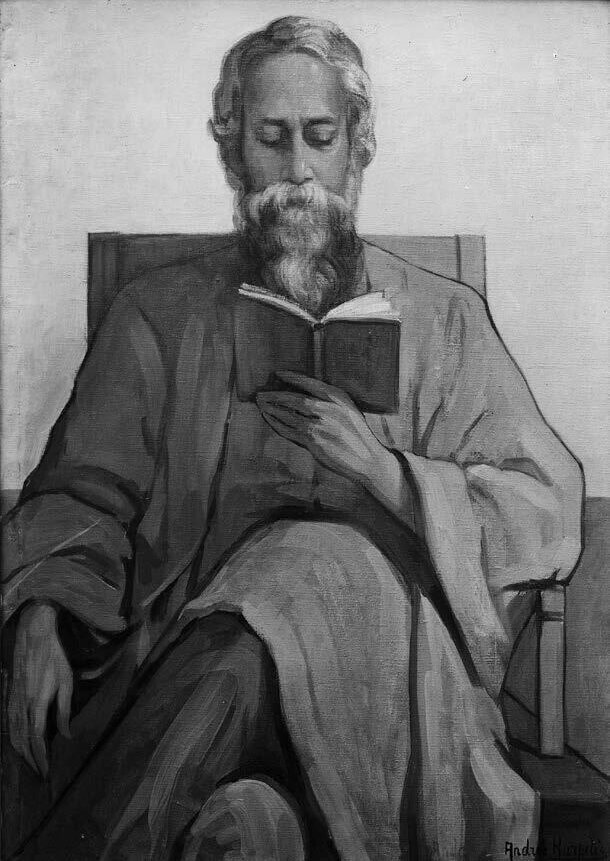
1) Photography of A.K.‘s Portrait of Rabindranath Tagore, 1920 [source: Marie Olivier/MPP]. 2) A.K.‘s woodblock illustration in Milindapanha’s translation by Louis Finot, 1923. 3) Neang Kakey, A.K.‘s woodcut in G.H. Monod, Contes khmers, 1943.
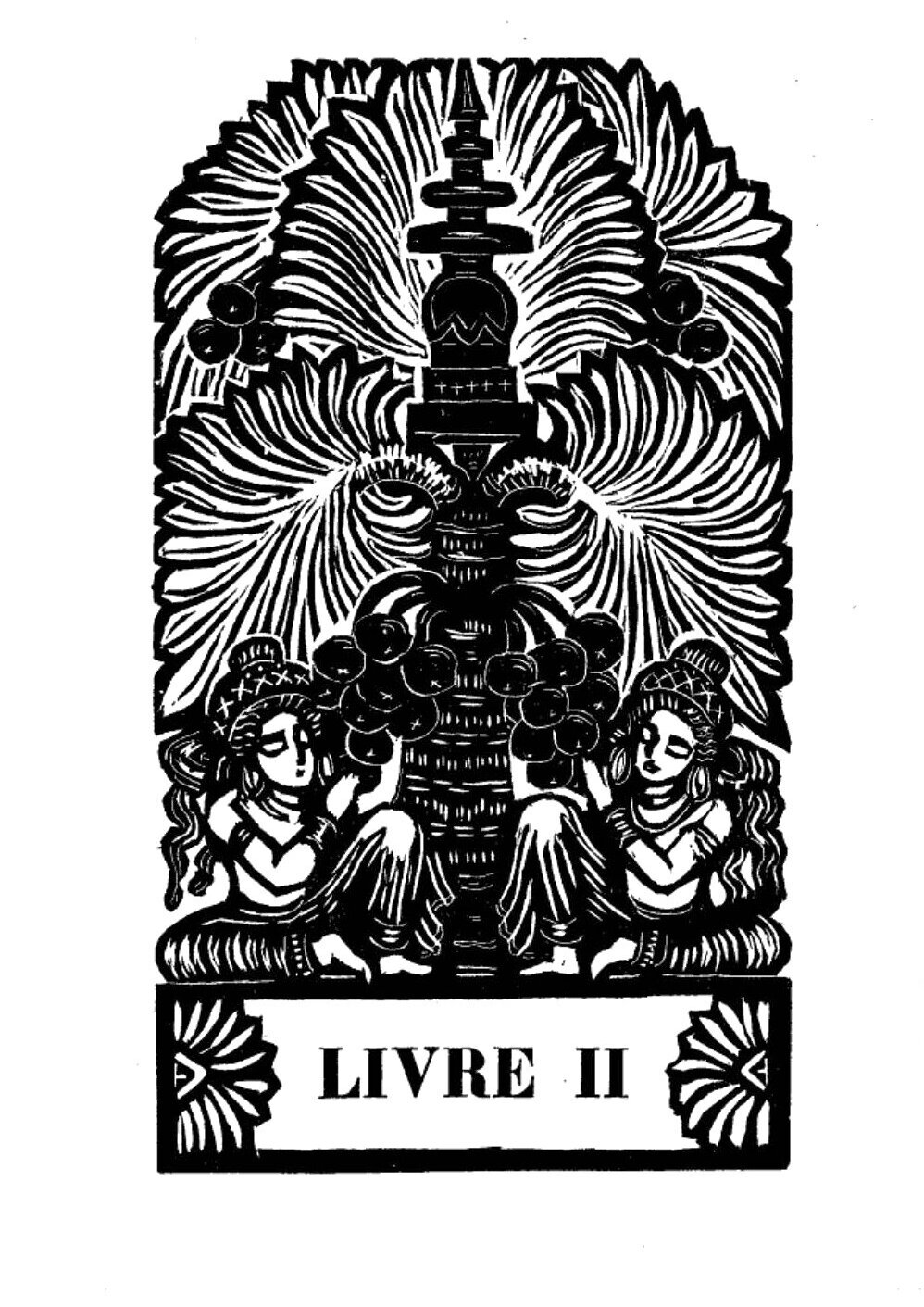
1) Photography of A.K.‘s Portrait of Rabindranath Tagore, 1920 [source: Marie Olivier/MPP]. 2) A.K.‘s woodblock illustration in Milindapanha’s translation by Louis Finot, 1923. 3) Neang Kakey, A.K.‘s woodcut in G.H. Monod, Contes khmers, 1943.
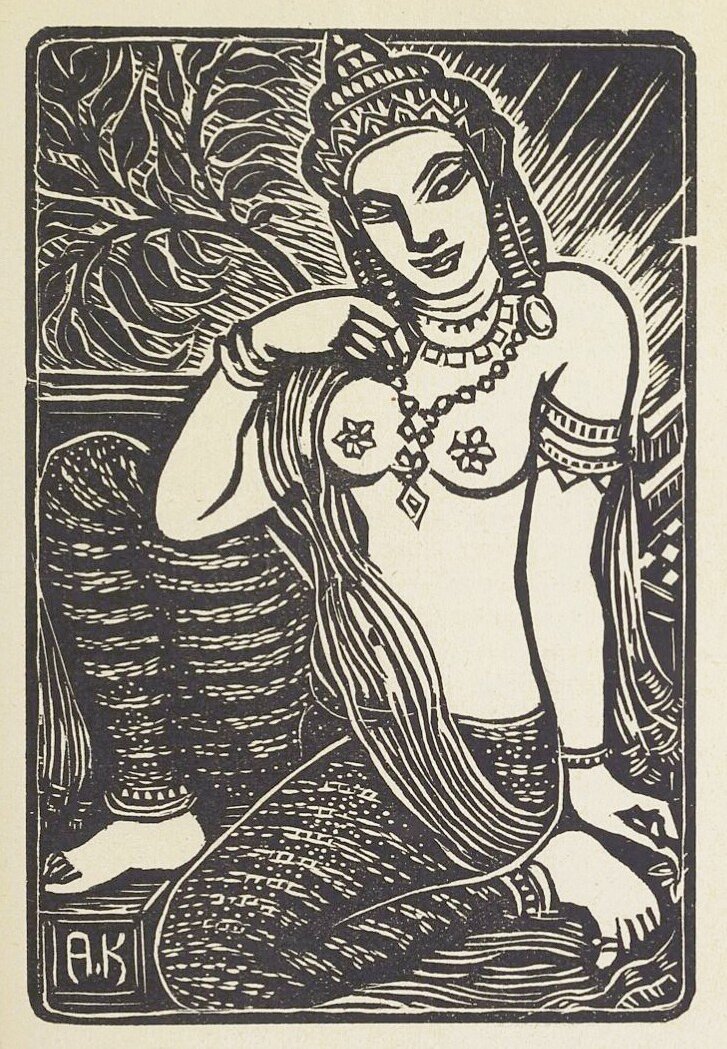
1) Photography of A.K.‘s Portrait of Rabindranath Tagore, 1920 [source: Marie Olivier/MPP]. 2) A.K.‘s woodblock illustration in Milindapanha’s translation by Louis Finot, 1923. 3) Neang Kakey, A.K.‘s woodcut in G.H. Monod, Contes khmers, 1943.
1) Photography of A.K.‘s Portrait of Rabindranath Tagore, 1920 [source: Marie Olivier/MPP]. 2) A.K.‘s woodblock illustration in Milindapanha’s translation by Louis Finot, 1923. 3) Neang Kakey, A.K.‘s woodcut in G.H. Monod, Contes khmers, 1943.
During Second World War, Andrée and Carl adopted the daughter of a Jewish couple who were sent to and perished in a Nazi concentration camp, and Andrée allowed later that she had been struck by the orphaned girl’s physical likeness with poet Tagore’s youngest daughter, Nandini. Flora Hogman, who went to settle in New York in the 1960s, donated in 2011 several works by her adopted mother to the Rabindra Bhavan Collection in Shantiniketan.
Translations, Illustrations, Contributions
- [tr. with Tapanmohan Chatterji, illustr.] Abindranath Tagore, L’Alpona ou les décorations rituelles au Bengale, Paris, Bossard, 1921 [woodcuts, drawings]
- [tr. and illustr., preface by Victor Goloubew] Abanindra Nath Tagore, Art et anatomie hindous, Paris, Bossard, “Les Classiques de l’Orient”, 1921, 88 p.
- [illustr.] Marguerite Ferté, Ghazels, Paris, Bossard, 1925.
- [tr. and illustr.] Samarendranath Gupta, Les Mains dans les fresques d’Ajanta, coll. « La petite collection orientaliste », Paris, Bossard, 1921. [drawings]
- [tr. and pres.] Abanindranath Tagore, Sadanga ou les six canons de la peinture, coll. « La petite collection orientaliste », Paris, Bossard, 1922.
- [illustr.] Sylvain Lévi (tr.), La légende de Nala et Damayanti, coll. “Les Classiques de l’Orient”, Paris, Bossard, 1920. [woodcuts]
- [illustr.] Gaston Courtillier, La légende de Rama et de Sita, extraite du Ramayana de Valmiki, Paris, Bossard “Les Classiques de l’Orient”, 1927, 272 p. [woodcuts and drawings]
- [illustr. and pres.] Abanindranath Tagore, La Poupée de fromage, Mouans-Sartoux, éditions Chitra, 1933.
- [tr. and illustr.] Abanindranath Tagore, Sakountala (racontée à la jeunesse) suivie de Nalaka„ Mouans-Sartoux, C.A. Högman Publications Chitra, coll. Feuilles de l’Inde, 1937. [woodcuts]
- [tr and illustr.] Abanindrantah Tagore, Rondes et Berceuses, Mouans-Sartoux , C.A. Högman Publications Chitra, coll. “Feuilles de l’Inde 7”, 1939. [ENG tr. by Tapanmohan Chatterji, Nursery Rhymes, 1932].
- ‘An Introduction to Abanindranath Tagore’s Sadanga’, Visva-Bharati Quarterly, Abanindra Number, 8.1−2, May – October 1942, and Modern Review, 91(4), April 1942:328 – 30 (ENG tr. by A. Aronson).
- [illustr.] G.H. Monod, Contes Khmers, C.A. Högman Publications Chitra, coll. “Feuilles de l’Inde 9”, 1943.
- ‘Abanindranath Tagore’, The Aryan Path, vol. XXIII‑3, 1952, p 118 – 128.
- [illustr.] Rabindranath Tagore, À quatre voix (Chauranga), Gap, Publications Chitra, éditions Ophrys, 1954.
References
- Udaya Narayana Singh, “Andrée Karpelѐs and Santiniketan: Letters from Flora Hogman Archive,” Rabindra Viksha Vol 53: 21 – 35 [English version via ResearchGate, May 2020]
- Marie Olivier, “L’exposition et la réception en France de l’École du Bengale. Parcours croisés d’Abanindranath Tagore (1871−1951) et d’Andrée Karpelès (1885−1956)”, Art Asie Sorbonne, 2024 [via hal.fr]
- Marie Olivier, “Andrée Karpelès (1885 — 1956), une artiste voyageuse. Conférence à la Villa Saint-Hilaire”, Exposition “Féminin Singulier, des grassoises étonnantes au tournant du XXème siècle”, Bibliothèque Villa Saint-Hilaire, Apr. 2022, Grasse, France.
- Marie Olivier, “Andrée Karpelès (1885−1956), une artiste au cœur des échanges franco-indiens”, INHA, 10 March 2022.
- Amandine Dazedevo, “L’attrait de l’Orient : les illustrations d’Andrée Karpelès”, Bulac-Hypotheses, 29 March 2018.

